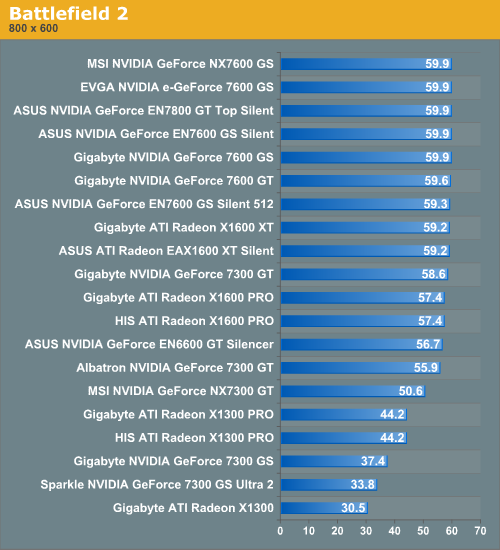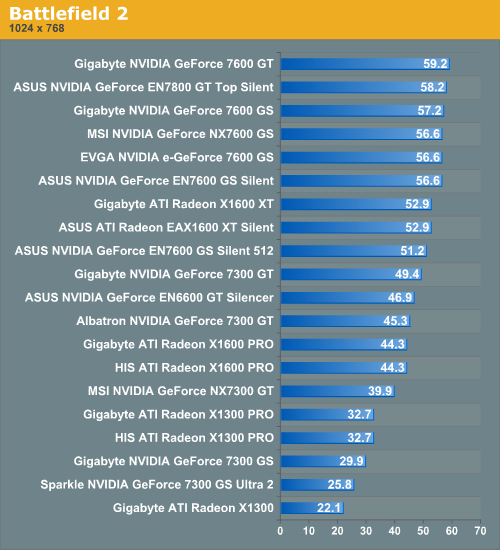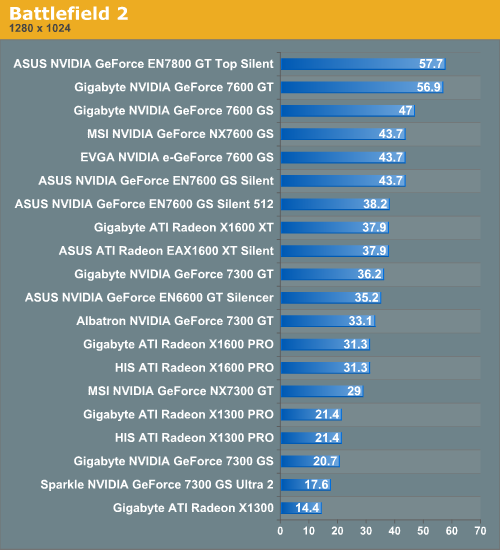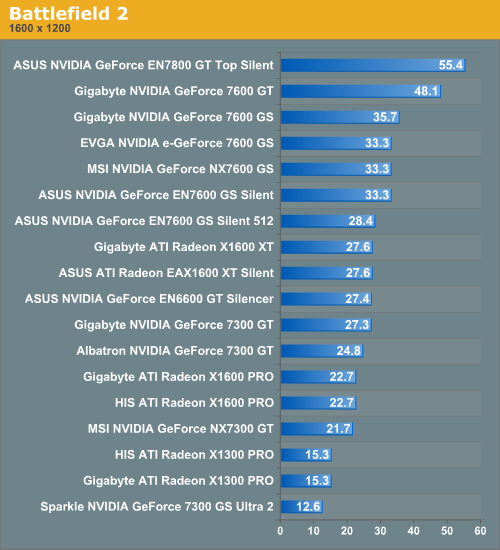Battlefield 2
Battlefield 2 is a game that has been a valuable asset to our GPU testing, and it's one of our absolute standards for present-day gaming. The game is one of the most popular that we test, and it is still one of the best reasons to upgrade your graphics card. Our benchmark for this game is basically a third-person view of a player on foot and in a few different vehicles, including a jet. This gives us a wide view of the action in the different vehicles and on foot in order to get a test which covers a wide range of gameplay. We tested Battlefield 2 with the graphics settings on "High" quality.




When testing Battlefield 2, we noticed a strange graphical issue with our 7300 GS cards, the Sparkle 7300 GS Ultra 2 and the Gigabyte 7300 GS. For some reason, ground textures show up as white (blank) when in third-person view, and strange motion trails follow the characters and vehicles (as well as some structures). We're not sure why this happens (it's possibly a TurboCache issue, as these cards use this technology), but there aren't any graphical problems when in first-person mode. This will be a significant inconvenience for any BF2 players who like using third-person view (as this editor does) when in certain vehicles like the hum-vee.
A pattern we will see throughout all of these tests is that the ASUS EN7800 GT Top Silent will stand out as the highest performer, particularly in the higher resolutions. This is the advantage of a part that has a higher number of pixel pipelines (20) and is a higher-end part in general. However, with the extra performance comes a higher price tag and higher temperatures, and this silent 7800 GT from ASUS is hard to find on sale at the time of this writing. (MSI also manufactures a silent 7900 GT card which would further improve performance, although unfortunately it is apparently only available in European markets.)
In the graphs above, the first thing we notice is an overhead of about 60 fps at the lowest resolution for a lot of the cards. The game runs well on most of the cards at this setting, and even the slowest cards can run the game at a playable frame rate. Because things like sniping are part of the game play in Battlefield 2, 800x600 is not an ideal resolution unless you are only playing on the smallest maps. 1024x768 is more suitable for medium to large games, so this is something to consider while looking at performance.
We can see that on the low end, the X1300 performs worse that the Sparkle 7300 GS up until you get to the higher resolution. This isn't helpful though because none of these cards are really playable over 1024x768. If you want to be able to play Battlefield 2 at 1600x1200 on "high" quality, you will probably need at least an X1600 XT to do so.
As a side note, we can see how the factory overclocks on cards like the Gigabyte and Albatron 7300 GT and Gigabyte 7600 GS give a few extra frames of performance over the other cards of the same type. Cards like these will naturally have a slight edge in performance over the reference clocked ones which is always something to consider when looking at card prices.
Battlefield 2 is a game that has been a valuable asset to our GPU testing, and it's one of our absolute standards for present-day gaming. The game is one of the most popular that we test, and it is still one of the best reasons to upgrade your graphics card. Our benchmark for this game is basically a third-person view of a player on foot and in a few different vehicles, including a jet. This gives us a wide view of the action in the different vehicles and on foot in order to get a test which covers a wide range of gameplay. We tested Battlefield 2 with the graphics settings on "High" quality.




When testing Battlefield 2, we noticed a strange graphical issue with our 7300 GS cards, the Sparkle 7300 GS Ultra 2 and the Gigabyte 7300 GS. For some reason, ground textures show up as white (blank) when in third-person view, and strange motion trails follow the characters and vehicles (as well as some structures). We're not sure why this happens (it's possibly a TurboCache issue, as these cards use this technology), but there aren't any graphical problems when in first-person mode. This will be a significant inconvenience for any BF2 players who like using third-person view (as this editor does) when in certain vehicles like the hum-vee.
A pattern we will see throughout all of these tests is that the ASUS EN7800 GT Top Silent will stand out as the highest performer, particularly in the higher resolutions. This is the advantage of a part that has a higher number of pixel pipelines (20) and is a higher-end part in general. However, with the extra performance comes a higher price tag and higher temperatures, and this silent 7800 GT from ASUS is hard to find on sale at the time of this writing. (MSI also manufactures a silent 7900 GT card which would further improve performance, although unfortunately it is apparently only available in European markets.)
In the graphs above, the first thing we notice is an overhead of about 60 fps at the lowest resolution for a lot of the cards. The game runs well on most of the cards at this setting, and even the slowest cards can run the game at a playable frame rate. Because things like sniping are part of the game play in Battlefield 2, 800x600 is not an ideal resolution unless you are only playing on the smallest maps. 1024x768 is more suitable for medium to large games, so this is something to consider while looking at performance.
We can see that on the low end, the X1300 performs worse that the Sparkle 7300 GS up until you get to the higher resolution. This isn't helpful though because none of these cards are really playable over 1024x768. If you want to be able to play Battlefield 2 at 1600x1200 on "high" quality, you will probably need at least an X1600 XT to do so.
As a side note, we can see how the factory overclocks on cards like the Gigabyte and Albatron 7300 GT and Gigabyte 7600 GS give a few extra frames of performance over the other cards of the same type. Cards like these will naturally have a slight edge in performance over the reference clocked ones which is always something to consider when looking at card prices.










49 Comments
View All Comments
imaheadcase - Thursday, August 31, 2006 - link
I guess to each his own, i play bf2 on a 19inch CRT monitor at 1024x768. But even if i had a better card i would still prefer lower rez.DerekWilson - Thursday, August 31, 2006 - link
it's an issue of how games work on the inside ...all the objects, shapes, characters, and landscapes are there no matter how you see them. everything is mathematically represented in the software. rendered onto your display is a viewport into the world. this viewport only allows you to see a fixed grid of colors. the color of each pixel is determined by a bunch of factors, but the largest contribution is made by the object that projects onto a particular pixel.
... on second thought, this is too hard for me to explain with out a lot of math. lets look at it another way.
when there's a naked person on tv, they decrease the resolution of the area over the persons naughty bits. this makes it harder to see what's really there because there is a smaller number of large pixels that can only represent one color each. it follows, then, that it would also be harder to shoot the person acurately in said bits.
I think your preference may be based on your experience with performance at higher resolutions. Responsiveness is necessary for a quality experience in games like bf2. If you get a faster card, I would encourage you to at least try a higher resolution.
blckgrffn - Thursday, August 31, 2006 - link
When it is in stock at newegg, its ~$90, not nearly $140.Nat
mostlyprudent - Thursday, August 31, 2006 - link
I would be interested to know how much noise (quantitatively) an actively cooled 7600GS or 7600GT contributes to a system built in a relatively quiet case like an Antec P150. I am familiar with some of the leaf blowers attached to the higher end cards, but wonder how much overall system noise savings you'ld get in the mid-range cards.wilburpan - Thursday, August 31, 2006 - link
One obvious use for silent video cards would be in an HTPC system, where quiet performance would be a priority. Can't have those noisy computer fans intrude on watching Snakes on a Plane, you know. :@) Anyway, it would have been nice to include some video playback benchmarks to see how these cards can handle playing back a 1080p HDTV signal, or similiar tests.ViRGE - Thursday, August 31, 2006 - link
Since HDTV is MPEG2, any modern video card should be able to handle a 1080P signal(since this is an either/or case, it either can or can't). The limitations come in to H.264, where the video decode engine may not be clocked high enough to do higher resolution decoding. Unfortunately, I'm not sure there's any 1080 commerical/usable content that would work with Cyberlink/Intervideo's H.264 decoders(the only ones with GPU acceleration), since Quicktime content doesn't work in those.DerekWilson - Thursday, August 31, 2006 - link
with nvidia, the video decode engine is clocked off the core -- it actually will run better on a card with fewer pipelines and a higher core speed ... iow, the 7600gt is a better video decode graphics card than a 7900gt at default clock speeds.a little counter intuitive, but there it is.
nvidia 7 series parts with a core clock of >450 MHz should have no problem accelerating 1080p decode on players that support purevideo.
MontagGG - Thursday, August 31, 2006 - link
Which of these have HDCP?DerekWilson - Thursday, August 31, 2006 - link
to my knowledge, none of the cards tested here support hdcp. but I will certainly try to confirm this ...